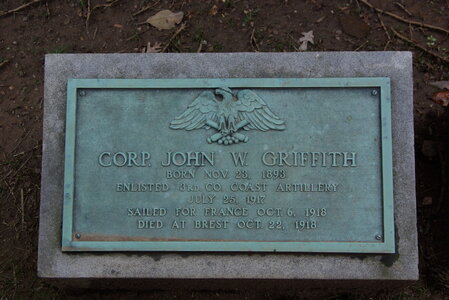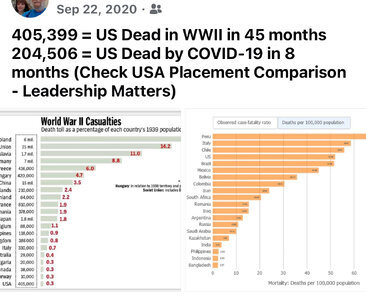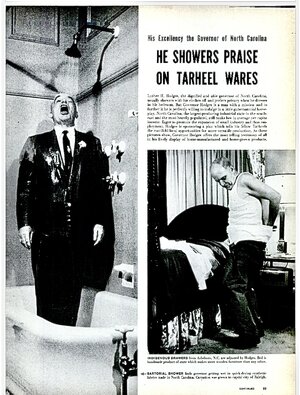Navigation
Install the app
How to install the app on iOS
Follow along with the video below to see how to install our site as a web app on your home screen.
Note: This feature may not be available in some browsers.
More options
You are using an out of date browser. It may not display this or other websites correctly.
You should upgrade or use an alternative browser.
You should upgrade or use an alternative browser.
In The Archives: This Date in History
- Thread starter donbosco
- Start date
- Replies: 1K
- Views: 158K
- Off-Topic
donbosco
Inconceivable Member
- Messages
- 4,425
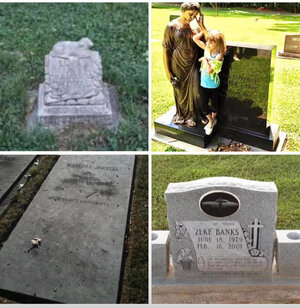
Even the youngest historian needs to be a rubbernecker. There’s no turning away from the past because it’s bad. I had learned about the Pandemic of 1918-1919 reading history books as a boy. For the most part, it had always been wrapped into the narrative of WW1 in those sources. Morbid topics need exploring and I have done my share. The very first article that I published focused on a typhus epidemic in the Guatemalan highlands and disputes over treatment and burials. It was titled, “A Cry at Daybreak: Death, Disease, and Defence of Community in a Highland Ixil-Mayan Village.” In keeping with the theme, I’ve always loved cemeteries and have spent many hours wandering through them imagining the stories, good and bad, buried there.
Some years ago we lived next door to New Garden Burial Grounds in Greensboro and I walked through it at least twice everyday. A very young Delilah and I often enjoyed perusing the markers. As my daughter and I passed through in the mornings, me heading to work at Guilford College, and she to Day Care at ‘A Child’s Garden’ at New Garden Friends Meeting, one memorial, that of Jayne Fentress Kemper Lamb, (1918-2005) - pictured below - always received a ‘Hello Miss Jayne’ from her.
As for me, I usually saluted the grave of poet Randall Jarrell (marker also pictured below) most known for his gruesome poem, ‘The Death of the Ball Turret Gunner.’
From my mother’s sleep I fell into the State,
And I hunched in its belly till my wet fur froze.
Six miles from earth, loosed from its dream of life,
I woke to black flak and the nightmare fighters.
When I died they washed me out of the turret with a hose. ~ R. Jarrell
&&&&&&@&&&&&&
The variety of decorations for recollecting the Dead always amaze me. Western North Carolina has some unique ones but so too does my favorite northern cemetery in Sleepy Hollow, just north of New York City. Likewise El Cemeterio General in Guatemala City is filled with marvels. The western highland Mayan city of Quetzaltenango is a good rival and the burial ground there is chock full of legends and haunting tales.
So often flags, carved symbols, and left-behinds reveal facts of the life, and the death, of those interred. For years I’ve also been on the lookout for First Pandemic tombstones during my wanderings. In particular for the years 1918-1919 there are more of the sad little reclining lambs that remember babies and toddlers. The ‘Blue Death’ of 1918-19 took many more infants — and with a sobering rapidity — than did our modern novel virus.
I was fortunate to survive our recent epidemic and I suppose there will have been plenty of new sod turned and monuments erected across the state, the nation, and the planet for me to identify and inventory. Should those who passed stubbornly unvaccinated bear some special marking as did the babies from the first so that we may know, at a glance, just where they stood and how they fell? I know historians would appreciate that kind of tombstone ‘heads-up.’
#OTD (September 19) 1918 “Spanish Flu” hit #Wilmington — within 1 week 400 were sick. 1918-19 saw 20% of the state infected. “The official death toll from the Spanish flu in North Carolina was around 13,700. Relative to today’s population, that would be about 56,000 fatalities.” See here: Historic Outbreak: Spanish Flu on NC Coast (on May 10, 2023 they stopped counting the death toll for NC for the 21st century Covid-19 Pandemic at 29,059 —See here: (Archive) COVID-19 Cases and Deaths Dashboard | NC COVID-19 )
In the early 20th century pandemic the sickness and death overwhelmed North Carolina’s State Health Care, itself a brand new idea and branch of government, and charity was pushed beyond its limits. See here our #OTD, September 19, 1918, when the virus was first detected in Wilmington: The Spanish Flu Epidemic of 1918
Another cemetery worth a visit is Bonaventure Cemetery in Savannah, GA. Johnny Mercer and Conrad Aiken are buried there. The live oaks and Spanish moss give it an eerie feeling.
Even the youngest historian needs to be a rubbernecker. There’s no turning away from the past because it’s bad. I had learned about the Pandemic of 1918-1919 reading history books as a boy. For the most part, it had always been wrapped into the narrative of WW1 in those sources. Morbid topics need exploring and I have done my share. The very first article that I published focused on a typhus epidemic in the Guatemalan highlands and disputes over treatment and burials. It was titled, “A Cry at Daybreak: Death, Disease, and Defence of Community in a Highland Ixil-Mayan Village.” In keeping with the theme, I’ve always loved cemeteries and have spent many hours wandering through them imagining the stories, good and bad, buried there.
Some years ago we lived next door to New Garden Burial Grounds in Greensboro and I walked through it at least twice everyday. A very young Delilah and I often enjoyed perusing the markers. As my daughter and I passed through in the mornings, me heading to work at Guilford College, and she to Day Care at ‘A Child’s Garden’ at New Garden Friends Meeting, one memorial, that of Jayne Fentress Kemper Lamb, (1918-2005) - pictured below - always received a ‘Hello Miss Jayne’ from her.
As for me, I usually saluted the grave of poet Randall Jarrell (marker also pictured below) most known for his gruesome poem, ‘The Death of the Ball Turret Gunner.’
From my mother’s sleep I fell into the State,
And I hunched in its belly till my wet fur froze.
Six miles from earth, loosed from its dream of life,
I woke to black flak and the nightmare fighters.
When I died they washed me out of the turret with a hose. ~ R. Jarrell
&&&&&&@&&&&&&
The variety of decorations for recollecting the Dead always amaze me. Western North Carolina has some unique ones but so too does my favorite northern cemetery in Sleepy Hollow, just north of New York City. Likewise El Cemeterio General in Guatemala City is filled with marvels. The western highland Mayan city of Quetzaltenango is a good rival and the burial ground there is chock full of legends and haunting tales.
So often flags, carved symbols, and left-behinds reveal facts of the life, and the death, of those interred. For years I’ve also been on the lookout for First Pandemic tombstones during my wanderings. In particular for the years 1918-1919 there are more of the sad little reclining lambs that remember babies and toddlers. The ‘Blue Death’ of 1918-19 took many more infants — and with a sobering rapidity — than did our modern novel virus.
I was fortunate to survive our recent epidemic and I suppose there will have been plenty of new sod turned and monuments erected across the state, the nation, and the planet for me to identify and inventory. Should those who passed stubbornly unvaccinated bear some special marking as did the babies from the first so that we may know, at a glance, just where they stood and how they fell? I know historians would appreciate that kind of tombstone ‘heads-up.’
#OTD (September 19) 1918 “Spanish Flu” hit #Wilmington — within 1 week 400 were sick. 1918-19 saw 20% of the state infected. “The official death toll from the Spanish flu in North Carolina was around 13,700. Relative to today’s population, that would be about 56,000 fatalities.” See here: Historic Outbreak: Spanish Flu on NC Coast (on May 10, 2023 they stopped counting the death toll for NC for the 21st century Covid-19 Pandemic at 29,059 —See here: (Archive) COVID-19 Cases and Deaths Dashboard | NC COVID-19 )
In the early 20th century pandemic the sickness and death overwhelmed North Carolina’s State Health Care, itself a brand new idea and branch of government, and charity was pushed beyond its limits. See here our #OTD, September 19, 1918, when the virus was first detected in Wilmington: The Spanish Flu Epidemic of 1918
donbosco
Inconceivable Member
- Messages
- 4,425
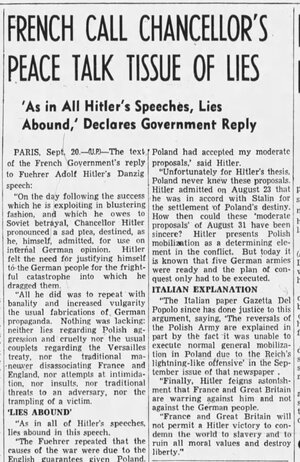

Article clipped from Oakland Tribune
Clipping found in Oakland Tribune published in Oakland, California on 9/20/1939.
donbosco
Inconceivable Member
- Messages
- 4,425
The Danzig Speech referred to above.
The Avalon Project : Address by Adolf Hitler - September 1, 1939
The Avalon Project : Address by Adolf Hitler - September 1, 1939
donbosco
Inconceivable Member
- Messages
- 4,425
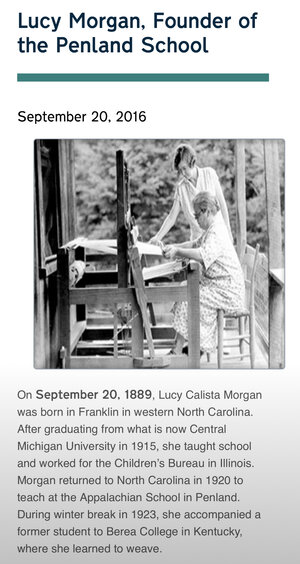

Lucy Morgan, Founder of the Penland School
Lucy Calista Morgan established the Penland School of Handicrafts in 1929. The Penland School of Crafts has grown to be the premier art craft school in the country.
donbosco
Inconceivable Member
- Messages
- 4,425
#OnThisDay, September 21, in 2021
“COVID-19 has now killed about as many Americans as the 1918-19 Spanish flu pandemic did — approximately 675,000. The 1918-19 influenza numbers are rough guesses. The population of the U.S. at the time was about one-third the size of what it is today.”
https://twitter.com/AP/status/1439990628960591876
“COVID-19 has now killed about as many Americans as the 1918-19 Spanish flu pandemic did — approximately 675,000. The 1918-19 influenza numbers are rough guesses. The population of the U.S. at the time was about one-third the size of what it is today.”
https://twitter.com/AP/status/1439990628960591876
superrific
Master of the ZZLverse
- Messages
- 10,210
So Danzig is known as Gdansk in Poland. And at least during the early 21st century, that was a touchy subject.The Danzig Speech referred to above.
The Avalon Project : Address by Adolf Hitler - September 1, 1939
- In it Hitler claimed that Poland had attacked Germany.
Ethnic Germans in Poland were being persecuted, even massacred.
Germany sought peace.
- Britain and France were the responsible ones.
- Danzig rightfully belonged to Germany.
- The conflict had been swift and clean.
I dated an Austrian woman who was born in Gdansk before her family defected. That's where most of her extended family lived. And they said Gdansk. She said Danzig, because that's how they taught it in Austria. She didn't understand why it had to be such a point of contention. I mean, she understood the reality; she just thought it was so silly. When around her cousins, she tried to say Gdansk but one time Danzig slipped out and she got yelled at.
In general, I really think countries need to accept the spellings and pronunciations of places used by the locals and the home country. The capital of Italy is Roma. Period. Greece: Athenai. Portugal: Lisboa. I don't know that anyone in those places care, but a uniform policy would remove subjectiveness of Danzig/Gdansk.
- Messages
- 1,537
I once received a lecture from a young Frenchman about how it was rude of me to not pronounce "Paris" the way it was said in France. After he was through, I asked how he pronounced the capital of Great Britian. He immediately gave the French pronunciation of London. When I responded that was not how it was prnounced in England, he immediately responded that it was not his fault those silly English didn't know to pronounce London.So Danzig is known as Gdansk in Poland. And at least during the early 21st century, that was a touchy subject.
I dated an Austrian woman who was born in Gdansk before her family defected. That's where most of her extended family lived. And they said Gdansk. She said Danzig, because that's how they taught it in Austria. She didn't understand why it had to be such a point of contention. I mean, she understood the reality; she just thought it was so silly. When around her cousins, she tried to say Gdansk but one time Danzig slipped out and she got yelled at.
In general, I really think countries need to accept the spellings and pronunciations of places used by the locals and the home country. The capital of Italy is Roma. Period. Greece: Athenai. Portugal: Lisboa. I don't know that anyone in those places care, but a uniform policy would remove subjectiveness of Danzig/Gdansk.
donbosco
Inconceivable Member
- Messages
- 4,425
Vince Carter dunks over 7'2” Frederic Weis of France, one of the greatest dunks in basketball history.
donbosco
Inconceivable Member
- Messages
- 4,425
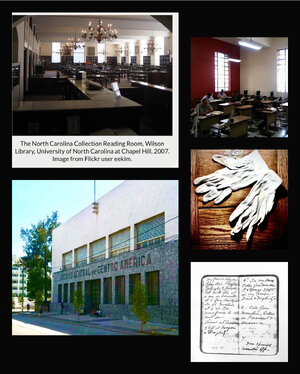
#Archives are fascinating places. #ArchivistsMakeTheWorldComeClear. Archives are where we find the Primary Documents of our individual AND collective pasts. The census rolls, birth, marriage, & death records, land surveys & sales, trial transcripts & court judgments, & licenses & certificates of achievement and so much more come to rest in government archives. Other Primary Sources — diaries, journals, letter exchanges, newspapers — are preserved in archival Special Collections. #Archivists arrange & sort & inventory & catalogue all of these things so that the rest of us can find them. Without archivists, all these things, these valued papers & artifacts that contain the stuff of the stories of our past, would either be scattered or rotting away in messy piles in basements & attics. They manage, preserve, & curate the very essence of our past & present.
I first worked in an archive in the North Carolina Collection @UNC. That reading room is a stunning place of austere beauty. I went there with little direction, no skill set, & a paltry sense of where I was. Good librarians nevertheless helped me find what I thought I needed. My next, & truest archival experience — in Guatemala — was so far beyond the North Carolina one as to be downright other-worldly. In the Archivos Generales de Centroamérica in the very heart of that Central American capital, I set about researching the ‘Rebellion of Atanasio Tzul’ as it was labeled — a seminal event in Guatemala’s independence process.
There, with a modern civil war as my backdrop, I learned just how little I knew, how Ill-prepared graduate school had thus far made me, & just how absolutely essential archivists were. Gregorio ‘Don Goyo’ Concoha Chet & other staff patiently taught me the ropes - all kinds of new words, their meanings, & the protocols behind them. Anna Carla Ericastilla was particularly kind & helpful there. They, & many others were literally my teachers. I’ve worked there many times over the years & actually have come to love the staccato street loudness & often pungent city aromas that consistently infiltrate the archive building, situated in a Zone One Ground Zero location in Guatemala City. My days spent there have been dear to me. I hope to return.
I worked once for a few days in the local archives in the Bartow County, Georgia town of #Cartersville. There a long-time archivist for The Etowah Valley Historical Society, @Linda Cochran, not only instructed me on the quirks of that filing system but went so far as to lock me inside as she ran errands & went home for lunch. She even brought back homemade chicken sandwiches when I couldn’t spare the time to break for my own lunch. There I worked on the records available of the time spent in #Guatemala (as ambassador) of Cartersville’s native son, Pierce Manning Butler Young. The ever-kind Ms Cochran, who is Cherokee, gifted me a Good Will piece that I still keep on my office desk.
In #Asheville we’ve got an embarrassment of riches - a Treasury of Archivists if you will, in UNCA’s own Gene Hyde (now retired) & Ashley McGhee Whittle. Over at the City of Asheville’s #PackLibrary, Katherine Cutshall is doing amazing work in making a local institution respond to the needs & wants of Buncombe County people & communities.
This life spent in dusty rooms, white-gloved & handling decaying papers marked with fading ink formed into handwriting as individualized & eccentric as the past itself has been a constant joy. I’ve not produced as much in the realm of publications as most of my colleagues but I hope I’ve been able to share the sense of the past that work in archives has brought to me with the thousands of students who have passed through my classroom in my time teaching. I have to think there has been value added there. Today’s #OnThisDay is about one of North Carolina’s most important Archivists.
#OTD (Sept. 26) in 1911 Adelaide Fries was appointed as archivist of Southern Province of The Moravian Church. Born in 1871, she was drawn to primary sources, language, & history early. She preserved & collected while also writing. She died 1949 & was buried in God’s Acre. Read on at this link: Adelaide Fries and the Moravian Archives
Share:

